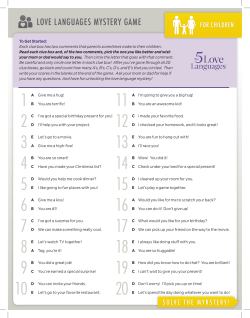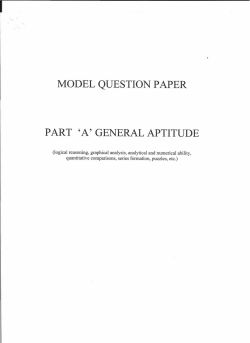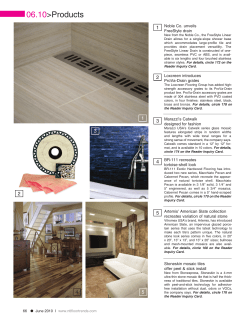
PROOF, PATTERN, CONJECTURE (1) ( Counting subsets) {dog, cat}
PROOF, PATTERN, CONJECTURE
MATH CIRCLE (BEGINNERS) 04/15/2012
(1) (Counting subsets) A set is a collection of objects (called elements), which we
often write as a list between curly braces. One set is {dog, cat}, another is {1,2,3,4,5},
and a third is {}. The last one is the empty set, which has no elements. Every set has
some number of subsets, which are sets that contain only elements in the original
set (but not necessarily all of them). {dog, cat} has 4 subsets: {}, {dog}, {cat}, and
{dog, cat}. (Notice we count both the empty set, and the original set, as subsets of
the original set.)
(a) How many subsets does the empty set {} have?
(b) How many subsets does {1} have?
(c) How many subsets does {1,2} have?
(d) How many subsets of {1,2,3}?
(e) How many subsets of {1,2,3,4}?
(f) How many subsets of {1,2,3,4,5}?
(g) Can you guess how many subsets an n-element set has, in terms of n?
c
Copyright 2008-2011
Olga Radko/Los Angeles Math Circle/UCLA Department of Mathematics .
1
LAMC handout
2
(2) (Hex Numbers) Hex numbers are formed by arranging dots in hexagonal shapes
with an increasing number of dots per side. The first three hexagonal numbers are
H1 = 1, H2 = 7, and H3 = 19, as demonstrated below:
Draw pictures which represent H4 and H5 :
Now compute the following partial sums of the hex number sequence:
H1 =
H1 + H2 =
H1 + H2 + H3 =
H1 + H2 + H3 + H4 =
H1 + H2 + H3 + H4 + H5 =
Do you see a pattern? Do you think it continues? How do you know?
LAMC handout
3
(3) (Goldbach’s Conjecture) The number 4 is a sum of two primes, namely 4 = 2 +
2. Likewise 6 is a sum of two primes, 6 = 3 + 3, and 8 = 3 + 5. Try the next several
even numbers–can you write each one as a sum of two primes?
10 =
12 =
14 =
16 =
18 =
20 =
Do you think this pattern continues (is every even number the sum of two primes)?
LAMC handout
4
(4) (Euler’s Polynomial) Consider the expression n2 + n + 41. If you plug in zero, you
get 02 + 0 + 41 = 41. If you plug in 1, you get 43, and if you plug in 2, you get 47. What
do you get when you plug in the next several numbers? What do all the results have
in common? (Hint: It’s more than just that they’re all odd...)
02 + 0 + 41 = 41
12 + 1 + 41 = 43
22 + 2 + 41 = 47
32 + 3 + 41 =
42 + 4 + 41 =
52 + 5 + 41 =
62 + 6 + 41 =
72 + 7 + 41 =
82 + 8 + 41 =
92 + 9 + 41 =
102 + 10 + 41 =
Do you think this pattern continues? How do you know?
LAMC handout
5
(5) (Circles and chords) Here are two circles. The first has one point on it, and 1
region inside. The second has two points connected by a line segment (or chord),
with 2 regions inside:
(a) Draw a circle with three points on it, and connect each pair of points by a chord.
How many regions does the circle have?
(b) Draw a circle with four points on it, and connect each pair of points by a chord.
How many regions does the circle have?
LAMC handout
6
(c) Draw a circle with five points on it, and connect each pair of points by a chord.
How many regions does the circle have?
(d) Can you guess how many regions a circle with n points on it would have, in terms
of n?
(6) (Odd squares) Write down any odd number:
Square it:
Take the remainder on division by 8:
Compare with someone else at your table. Try several different odd numbers. Is there
a pattern? Does it always hold?
LAMC handout
(7) (Compare the numbers) Use a calculator to compare
you find?
7
p√
9.1 and 33/19. What do
(8) (Hailstone numbers) Start with any positive whole number n, and create a sequence by doing the following process:
• If the current number is even, divide by 2.
• If the current number is odd, multiply by 3 and add 1.
For instance, if we start with 3, our sequence will be 3, 10, 5, 16, 8, 4, 2, 1, 4, 2, 1, ...
Try some examples yourself–for instance, starting with 7.
As you see, once the sequence reaches 4, 2, or 1, it will start to repeat itself. Question:
Does every starting number lead to a sequence which eventually cycles 4, 2, 1, ...?
What do you think?
LAMC handout
8
(9) (Armen’s Identity) Write down the first several cube numbers:
13 = 1
23 = 8
33 =
43 =
53 =
63 =
Now consider their partial sums (just as we did with the hex numbers earlier):
13 = 1
13 + 23 =
13 + 23 + 33 =
13 + 23 + 33 + 43 =
13 + 23 + 33 + 43 + 53 =
13 + 23 + 33 + 43 + 53 + 63 =
What kind of numbers are appearing? Is there a deeper pattern? Do you think it
continues?
© Copyright 2025
















